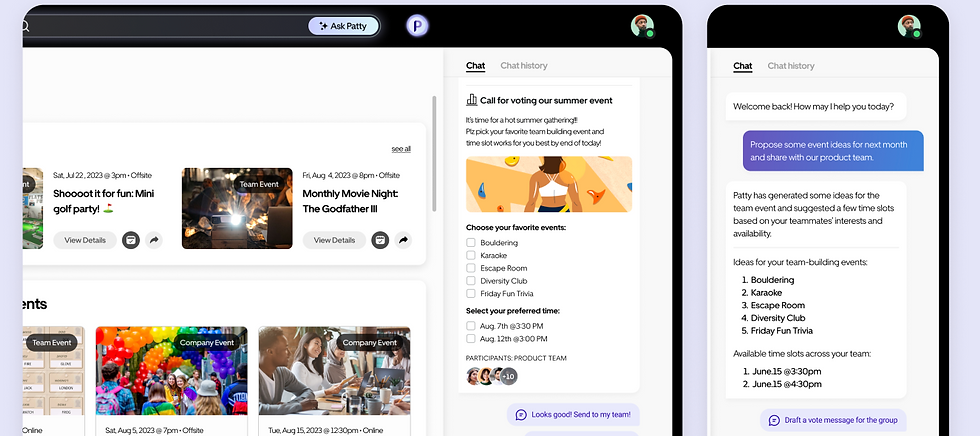Revamp the roadmap of clean energy mining trucks
Company
First Mode
Methods used
Ethnography
Interviews
Contextual inquiries
Field studies
Project length
6 months (July 2023 - January 2024)
Other skills involved
Data visualization
Research repository design
Communication & Negotiation
Cross-functional stakeholder management
Research team size
1 UX researcher (me)
Research audience
Human-Centered Design team
Engineering teams
Business Development team
Leadership
IMPACT
-
Kicked off 3 new cross-functional product projects,
-
Enhanced customer relationships with 7 more enterprise customers.
-
Elevated cross-team research efficiency by 200%.
See how I made these happen.
DOMAIN CONTEXT
If you've never visited a mine, here's what you need to know before reviewing my case study...
1. What is a mine?
Let's start with a fruit cake. If we only want the fruits, we can peel away the layers one by one and pick them out.
Imagine a cake that's 5 miles (8 km) long, 2 miles (3 km) wide, and 500 ft (150 m) deep.
That’s an open-pit mine—the most common type used worldwide for extracting gold, diamonds, copper, coal, and more.
Fruit cake

Open-pit mine

2. What is a mining truck?
An open-pit mine typically operates with a fleet of 30 to 80 mining trucks to transport mining materials and dispose of dust and dirt. A mining truck is huge—usually 16 yards (15 m) long, 8 yards (7 m) high, and 10 yards (9 m) wide.
Mining truck

An open-pit mine relies on hundreds of workers to support its mine operations, centered around the mining trucks.
These workers handle driving, refueling, dispatching, maintenance, and other essential tasks to ensure the trucks operate efficiently and mining activities run smoothly.

3. What is mine operations?
Mine operations
With hundreds of people working day and night, a mine is like a small town with their own social structure and culture.
BACKGROUND
First Mode designs and manufactures clean energy mining trucks for mining companies with decarbonization needs.
Traditional mining trucks run on diesel, leading to significant daily carbon emissions. Recently, more mining companies have begun transitioning to decarbonization. Recognizing this trend, First Mode developed clean energy mining trucks that use hydrogen and other clean energy sources to reduce carbon emissions.
Partnering with Anglo American plc, First Mode's trucks are already in use at a mine in South Africa.
Now, First Mode is expanding its customer base in Australia and North America.

PROBLEM
How can we make clean energy mining trucks more desirable to attract more customer interest?
No new customers in Australia and North America were interested in purchasing First Mode’s clean energy mining trucks.
First Mode initially assumed that building a feasible and capable mining truck would naturally attract interest from mining companies. This assumption proved incorrect.
The Human-Centered Design team then proposed that making the truck more desirable to mining companies could help First Mode attract more customers.
Time constraint
No preset deadline, just urgent
Research team size
1 UX researcher (me)

DIVING DEEPER INTO THE PROBLEM
I identified a clear research goal and the appropriate methodology through stakeholder conversations and previous research review.
Reviewed all the previous UX research conducted by designers
Had stakeholder conversations with designers, engineers and the business development team
Conducted qualitative analysis on previous team meeting notes between all the stakeholders
INSIGHT 1
Previous research focused too much on the interactions between the truck drivers and the trucks, not the whole mine operations.
IMPACT
-
Determined the research goal to be understanding the whole picture of the current mine operations to identify new product directions for the clean energy mining trucks
-
Determined the methodology to be ethnography, as it's well-suited for studying rich-context environments with unique social structures and cultures.
INSIGHT 2
I needed to communicate research insights with designers, engineers, the business development (BD) team and leadership to amplify user voices and research impact.
The communication path:
BD team
Me
Designers
Engineers
All 3 teams
Leadership
IMPACT
-
Identified the research audience to keep in mind and align with throughout the project.
CHALLENGES
I clarified four key challenges that needed to be addressed when deciding on the research approach.
Complex mine operations
Over 40 different types of workers interact with the truck throughout the daily work process.
How can I create a clear data structure that captures key details and delivers a compelling data narrative for stakeholders?
Multi continental scope
First Mode's target markets—South Africa, Australia, and North America—have varying mine operations.
How can I distinctly highlight regional differences and ensure accurate research insights for projects across various continents?
Limited user access
Access to mine sites is highly restricted.
How can I secure rich data sources for primary research?
Diverse research audience
Designers, engineers, business development teams, and leadership have different perspectives.
How can I effectively communicate the data story to cross-functional stakeholders?
MY RESEARCH APPROACH
I designed a 3-phase research approach to execute the ethnographic study and address all the research challenges.
Phase 1
Built mine operation maps with existing research data
Phase 2
Ethnographic interviews with mine managers
Phase 3
Field studies and contextual inquiries in mine sites
Phase 1: Built mine operation maps
Inspired by navigation apps like Google Maps, I used the zoom-in and zoom-out features of whiteboard tools like Miro to build mine operation maps with existing research data, creating a clear data structure that allowed everyone to view the entire mine at different levels of detail.
Example:
LEVEL 1
The entire mine
LEVEL 2
One operation group
LEVEL 3
An individual worker

Zoom in to the maintenance group
LEVEL 1
The entire mine
LEVEL 2
One operation group
LEVEL 3
An individual worker
.jpg)
Zoom in to the truck operator
LEVEL 1
The entire mine
LEVEL 2
One operation group
LEVEL 3
An individual worker
.jpg)
Zoom out to the whole mine again
LEVEL 1
The entire mine
LEVEL 2
One operation group
LEVEL 3
An individual worker

IMPACT
-
Established a clear data structure for mine operations.
-
Highlighted operational differences across continents by creating distinct mine operation maps for each region.
-
Engaged stakeholders throughout the research project.
-
Maps are universally understood, making it easy to communicate insights with diverse stakeholders including designers, engineers, business development teams and leadership.
-
Stakeholders could easily and enjoyably pinpoint areas of interest on the map.
-
Phase 2: Interviews with mine managers
Faced with limited access to a mine site, I started by interviewing mine managers to gather as much useful data as possible. During these interviews, I built networks with managers to snowball recruit more participants and identify mine sites open to primary research.

INNOVATION TIME!
To ensure data collection and strengthen participant relationships, I innovated the interview framework by empathizing with participants.
I began by having a coworker interview me using a typical user interview template, noting my feelings as an interviewee to identify potential pain points.

INSIGHT
-
Strictly structured interviews place interviewees in a low-power position, where they only answer researchers' questions.
-
This low-power dynamic can make interviewees uncomfortable and hinder future conversations.
-
Limiting responses to predefined questions means researchers may miss out on valuable, unexpected insights.
-
Based on these findings, I developed a new interview framework to improve data collection and enhance participants' interview experience.
FEATURE 1
Conduct background research and clarify the researcher's assumptions about the participants.

FEATURE 2
Build the interview protocol by outlining major research questions and arranging them chronologically to help participants easily recall and share their own stories.

FEATURE 3
After the interview, compare what has actually happened with the protocol.

FEATURE 4
Reflect on both the major findings from the interview and potential improvements to the interview protocol for future conversations with the participants.

IMPACT
-
Collected rich data from 20+ hours of interviews with 6 mine managers and shared insights promptly through 7 workshops with designers and engineers.
-
Secured a mine site in Washington, US, for phase 3's field studies and contextual inquiries.
Phase 3: Field studies and contextual inquiries in mine sites
By this point, I was fully prepared with phase 1 and 2 findings to collect onsite data effectively and efficiently.
Mine field trip shopping list
-
Clear research goals
-
Flexible research protocols
-
Mine safety training certificate
-
Meeting reservations with mine workers
-
Steel-toe shoes, helmet and goggles
-
My favorite: Vegan chocolate cookies to build rapport rapidly!

After phase 3, I triangulated ethnography findings with CRM data from the business development team to identify a clear product direction for First Mode's clean energy mining trucks.
Scroll down to see what I discovered.
RESEARCH FINDINGS AND IMPACT
Finding 1: Mine seeks a holistic decarbonization program with a product ecosystem, not just a fleet of net-zero emission trucks.
Imagine we're in a multiverse where you've become a new truck driver. The mine you work in has just replaced all traditional diesel mining trucks with clean energy ones. What might happen?

-
As a truck driver with no prior training on clean energy mining trucks, you feel nervous about your safety and efficiency at work today.
-
Your driving trainer is concerned about how to effectively train and track driver performance without protocols specifically designed for clean energy trucks.
-
The maintenance supervisor, responsible for ensuring the trucks are safe before every shift, feels uncertain without a maintenance protocol for the new trucks.
-
The refueling team is overwhelmed with a busier schedule than before and is now understaffed.
-
Dispatchers, tasked with directing trucks to various mine sites and coordinating daily operations, have fewer trucks available as many are waiting for refueling.
-
Mine managers and company officers are shocked by the operational chaos and the drop in production.
To prevent all this, First Mode must begin developing a holistic decarbonization program that aligns with current mine operations.
IMPACT
-
Aligned designers and engineers to create a new product roadmap for clean energy trucks and kicked off 2 new product projects.
-
Resulted in collaboration interest from 7 more enterprise customers, reported by the business development team.
Finding 2: Culturally, the mine is not tolerant of changes.
I found a story about how automation, another trending transition where mines use algorithms instead of human workers to coordinate truck fleets, initially faced significant deployment challenges and led to costly investment losses for companies developing mine automation software. Success came after they adapted their products to fit current mine operations better.
“You can think about automation right? As an example. It has been hard for the mining company to push that forward in mines as well ‘cause the ground crew push back.”
—— A mining manager
“I mean…mine is…you’d better be really persuasive if you want people to change. I feel that’s also a core skill to my work, handle conflicts due to changes.”
—— A dispatcher
IMPACT
-
Enabled designers to leverage the automation story to persuade leadership to invest in more research efforts.
-
Secured the design team a role in a new truck field testing project for usability tests and increased human-centered design efforts.
Finding 3: When proposing changes in mines, communicate through established protocols.
Regardless of how well the decarbonization program aligns with mine operations, it will inevitably bring changes. To help the mine and people adapt more easily, First Mode must communicate with mines in their language—protocols.
“...full of all kinds of schedules and protocols on the hall walls of command center...”
—— My field observation notes
“Protocols is our love language.”
—— A mine manager
IMPACT
-
Inspired designers and engineers to kicked off 1 more new product project.
REFLECTION
What I did well
-
Quickly learned and communicated a complex, ambiguous remote topic to others.
-
Elevated the company's UX maturity by educating engineers on the human-centered design approach.
-
Made friends with coworkers!
“I was constantly impressed by your ability to take complex and messy things and make them not just organized but beautiful. Bringing order to chaos is a super power. Seeing the big picture and breaking it down into sequential and manageable parts is an incredibly useful skill.”
—— First Mode's design team director


“ I appreciate you walking me through some of your processes for collecting and interpreting user data. That has been very helpful for my conversations with mine experts.”
—— A First Mode engineer
What I would do differently

-
Think from a more holistic stand point: Mines choose and use mining trucks, but it's the mining companies that own these mines and make the purchasing decisions. I wish I could explore the connection between mines and mining companies further to uncover additional insights that could strengthen customer relationships.
-
Research limitation: We only had the time and resources to conduct field observations and contextual inquiries at a mining site in the U.S. during its closure stage (similar to an elder in a human's lifecycle). It would have been even better if we could have included mines in Australia and South Africa, as well as mines at different lifecycle stages, to conduct more comprehensive research.

